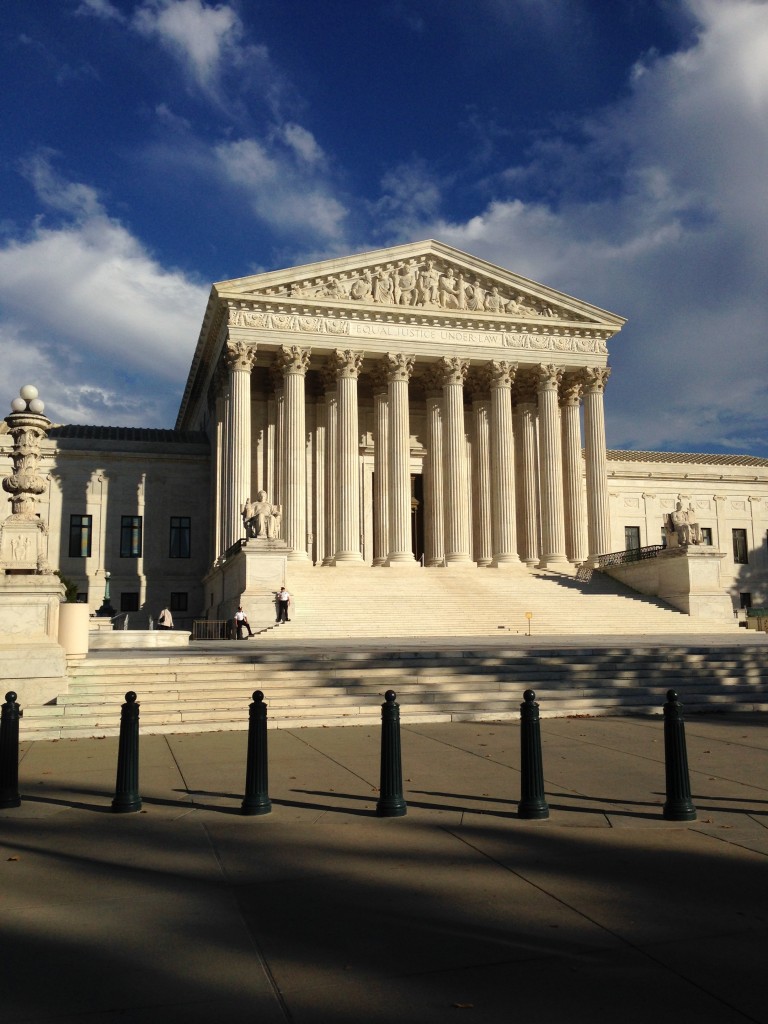Today we will kick off a two-part blog series titled SCOTUS Watch. In this series, we will look at cases before the United States Supreme Court this term that will have an impact on agriculture. Two cases will be heard this term, one involving the Clean Water Act and the other regulatory takings. Let’s get started.
The United States Supreme Court has agreed to consider US Army Corps of Engineer v. Hawkes Co., an important Clean Water Act (CWA) case. This case involves a topic much discussed recently–“waters of the United States.” Unlike the issues surrounding the EPA and Corps of Engineers (COE)’s new definition of what constitutes a water of the United States, this case looks at what a person can do if his or her property is deemed a water of the United States and the landowner disagrees with this determination.
Legal Background
Under the CWA, the Environmental Protection Agency and US Army Corps of Engineers (COE) are given authority over all waters of the United States. Specifically, if a person wishes to discharge point source pollutants into a water of the US or seeks to discharge dredge and fill material into a water of the US, he or she must obtain a federal permit from the EPA. The Hawkes case specifically involves the discharge of dredge and fill material, governed by Section 404 of the CWA.
Before engaging in activities that would result in the discharged of dredge and fill material, landowners may seek a determination from the COE, formally called an “approved jurisdictional determination” as to whether waters on their particular property constitute a water of the US, such that a permit is required. If the COE’s approved jurisdictional determination finds that waters of the US are present on a landowner’s property, the landowner may want to challenge this decision in court. Whether he has the right to make this challenge at this point in time, rather than waiting until a permit is obtained or an enforcement action is undertaken, is the key issue in this case.
Factual Background
Hawkes seeks to mine peat on 530 acres in Minnesota. In February 2012, the COE issued an approved jurisdictional determination concluding the property contained waters of the US and was subject to CWA jurisdiction. This was administratively appealed and a revised opinion issued in December 2012, concluding that 150 acres constitute a water of the United States.
Unhappy with this determination, Hawkes filed this lawsuit alleging that the determination was incorrect. The COE responded seeking dismissal because their jurisdictional determination was not a formal agency action for which judicial review was allowed.
The trial court dismissed the appeal, finding that the determination was not a final agency action allowing judicial review because it did not meet the second factor APA required for review. The appellate court (the Eighth Circuit Court of Appeals), reversed this decision, holding that a jurisdictional determination is a reviewable final agency action under the APA. The COE appealed to the United States Supreme Court.
Importantly, this decision created what is known as circuit spit–meaning that different federal appellate courts have reached opposite results. The Fifth Circuit Court of Appeals and the Ninth Circuit Court of Appeals previously found that a jurisdictional determination was not a final agency action, while the Eighth Circuit reached the opposite conclusion. Oftentimes, it is the existence of a circuit split that prompts the US Supreme Court to hear a case.
Supreme Court Case
The SCOTUS blog has a case page that will allow you to keep up with filings in the case. Additionally, here are links to review the Petition for Review filed by the COE, Response filed by Hawkes Co., and Reply by the COE.
The case will be considered by the country’s highest Court this spring, with oral argument set for March 30. A decision should be issued this summer.
Why Do We Care?
This case seeks to answer a critical question regarding the rights of landowners to challenge the decision of the COE/EPA that their property includes waters of the US, requiring a federal permit to undertake certain actions. Unfortunately, the same situation facing the development company could face agricultural producers as well.
For example, if a producer wanted to construct a new stock tank or plow new ground and the COE determined there to be waters of the US involved, the producer could find himself in Hawkes’ shoes. Without the option to appeal the determination to a court, the producer would have three undesirable choices: (1) He could abandon his plan to build the tank or plow the ground, hamstringing him with what he can do on his own property. (2) He could go through the permitting process to obtain the necessary federal Section 404 permit, but this could take years and thousands of dollars, meanwhile the cattle would not have the stock tank and the producer would not have his new field. (3) He could thumb his nose at the jurisdictional determination and proceed with his plans. If, however, the COE or EPA caught wind of this, they could begin an enforcement action against the farmer, who could face staggering fines of over $37,000 per day.
Moreover, producers across the country are extremely concerned about the new seemingly extraordinarily broad definition of “waters of the United States” adopted by the EPA and COE. Although currently stayed and not in effect, if the new definition of waters of the US does go into effect, many producers could find themselves in the undesirable position of being told their property contains waters of the United States and needing to challenge that decision. Thus, the Court’s forthcoming decision in Hawkes is likely more important now than ever before.












